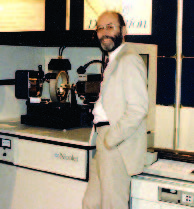Obituary - Ronald Emerson Burns (1943 - 2003)Obituary | Publications | Curriculum Vitae | Videos | Slides | Articles Ronald Emerson Burns (1943 - 2003)ACA RefleXions, Fall 2003
Ronald Emerson Burns, inventor of the Xentronics area detector, died at his home in Cambridge, Massachusetts on Friday, July 25, 2003, of cancer. He was 60. His invention of this accurate computer-based x-ray detector was one of the technological advances necessary to propel x- ray crystallography into the essential tool that it is today in the study of the molecular mechanisms of biology and disease. Burns’ invention replaced photographic film and conventional diffractometers with a faster, more accurate, and direct method of recording x-ray data into a computer – similar to replacing a conventional still camera with a digital video camera. High throughput x-ray crystallography, which would be impossible without area detectors, is now one of the most important tools used in cancer research. Ron Burns developed his advanced detector in the early 1980’s. He started the Xentronics firm to manufacture his detector in Cambridge, MA. Xentronics was sold to Nicolet Instruments in Madison, Wisconsin, which later sold the business to Siemens AG, which in turn, sold it to Bruker AXS. The first scientists to use the new detector were two researchers at Harvard University, Professor Stephen Harrison, and the late Professor Don Wiley. Using the technology developed by Burns, Harrison and Wiley examined the ways in which viruses bind to cell surfaces, enabling their entry into the cell. Harrison says “the Xentronics detector changed structural biology in a significant way.” Burns was a graduate of Princeton University. He referred to himself as an engineer. After Princeton, he worked at the High Energy Physics Lab at Harvard, while his spare time was devoted to working on and racing motorcycles. Leaving Harvard with only a mental picture of how his detector would function, he worked on his invention for years in his Cambridge basement, drawing on his mechanical intuition to design and build the tools needed to construct the detector. After successfully marketing the invention, he dedicated what turned out to be his remaining years to becoming an accomplished aerobatic pilot and instructor. Ron Burns is survived by his wife, Janet Burns, his son Jason Burns, and his granddaughter Ripley Burns, all of Cambridge, MA. - Paul Aho, Kevin Cameron, Stephen Harrison, and Michael Blum (From the Boston Sunday Globe, July 27, 2003). Photo - Ron Burns in the Nicolet Booth at the McMaster ACA meeting, 1986, with his Multiwire Detector, the P4-X1000. Photo by Sue Byram. |

